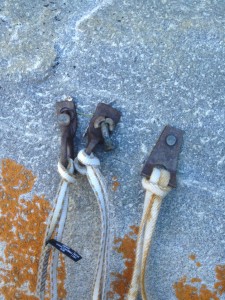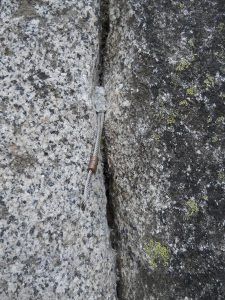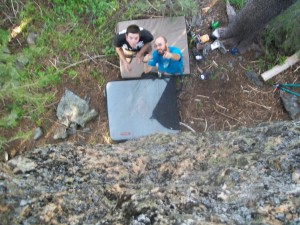I avoided work for a bit answering a question on Mountain Project’s Bigwall Forum about prewall prep. Felt like a good response came from it so I’ll post it here.
– – – – – – –
First came the question:
“I’m finally getting on El Cap in October, but I haven’t been training much besides cragging and 4 pitch routes in Pine Creek. Would I benefit much by doing an alpine route every week before hand, or should I put my efforts elsewhere? Maybe rope soloing cracks with a heavy rack and practicing solo aid and hauling???”
Then came my response:
If you haven’t bigwalled before then there’s two things you can do to maximize success on the wall. Long alpine routes are neither of those things. Think of Alpine routes as skinny-wheeled road biking and think of Bigwall routes as cross country offroad singletrack mountain bike touring (is that even a thing?)
#1
Practice cleaning a pitch on ascenders. I’ll say this again.
Practice cleaning a pitch on ascenders.
Cleaning a bigwall pitch is nothing like cleaning a freeclimbing pitch. This is where many people lose a lot of time. Cleaning a pitch on ascenders isn’t as much about fighting the protection pieces (that’s a given), it’s about fighting with the tension on the rope. It’s incredibly non-intuitive and frustrating as all hell.
Don’t practice cleaning straight up pitches. Focus on routes where the line wanders back and forth. Place pieces of protection that will make the rope break at hard angles. The best way to think of it is that when you’re done leading the pitch, the rope should look like the path of a rabbit trying not to be some hawk’s dinner. Make sure you’ve read up on how to pass a piece when cleaning. Make sure you’ve read up on how to lower-out off of a piece. Practice lowering out longer distances if the route you’re on is going to have a pendulum on it.
Ideally, if you can get a traversing route, especially under a roof, you’re golden because every single piece will require a lower-out or a super-awkward passing of the piece. (BACK YOURSELF UP AND ALWAYS USE A BINER IN THE TOP HOLE OF THE ASCENDER IF YOU’RE CLEANING A TRAVERSE) Granted, people will tell you that a traverse is usually easier to clean by re-aiding it backed up with your grigri and no ascenders at all and those people are correct, but we’re not here for easy, we’re trying to get as much practice cleaning situations where your second screwed you (and he/she will, oh yes, they will more than anyone ever has on a freeclimb)
#2
spend some time practicing hauling a full pig (~80lbs should be good) It’s not how to haul that needs to be practiced, but how to haul efficiently that will help you on the wall.
Choose different locations of anchors (hanging, small ledge to stand on, large ledge with anchors back from the edge) so you can get a feel for how the hauling process works differently in each scenario.
Make sure you work on docking the pig to the anchor and releasing the pig. Pay close attention to how the heavy pig, when docked to the anchor, will pin everything around it to the wall and make it impossible to open or remove some biners. Remember that when you’re choosing where to dock the pig the next time. Research Hudon’s methods of creating mini 2:1 hauls that he explains on his website.
If you’re small like me, set up a 2:1 ratchet and try that out compared to just using a single pulley 1:1. Use whichever one seems the best for your strength, mass, and ability to suffer. If you’ve got slab beneath you, practice space hauling (BACK YOURSELF UP ON A SEPARATE LINE FROM THE HAUL LINE) and if you’ve got a partner then practice two-man space-hauling.
Keep an eye on what kinds of things will catch the pig making it harder/impossible to haul it anymore. Remember that with a partner, they’ll have to stay below the pig (or rap back to it) if you notice something like that on the route. If you’re out there hauling solo and the pig gets caught, since you’re only practicing, don’t worry about doing a far-end haul, this is only practice after all and you’re not going to far-end haul if you’ve got a partner. So the way to cheat when you’re practicing alone (AFTER you’ve tried all sorts of rope tugging, lowering the bag to haul through the section again, etc) is to bring another rope (small tagline) and attach it to the bottom of your pig. When/If the pig gets stuck, take the tagline and put it through another pulley or biner or whatever and pull on that. This will pull the bottom of the pig up and (hopefully) away from whatever the pig is caught on then you can continue hauling. After you do this the first time, take a moment and give thanks to Plaidman (he’s the one that taught it to me when we were shooting the sheit in the manure pile parking lot after he came down from his 4-month long [give or take 14 weeks] Zodiac/Zenyata/ShortestStraw solo.)
Bigwall is a grand game of every single thing being relatively unimportant until it goes wrong and then IT’S THE MOST IMPORTANT THING OMG HOW COULD YOU NOT THINK OF THAT WE’RE GONNA DIE WHAT DO WE DO MUST BAIL NOW! so the more you practice the process of moving form one sequence to the next, the more you’ll give yourself the opportunity to randomly mess up and figure out how to fix it now and avoid it in the future.
One of the best phrases about bigwall was said to me on Mammoth Terrace as I was bailing because of equipment failure and general idiocy on my part, “It’s not the climbing that’ll get ya, it’s the carpentry.”
Practicing the climbing part of bigwall is important and fun but practicing everything inbetween the climbing is what’s going to determine whether you get to the top or return back to the ground.
Later on the incomparable Jeremy Aslaksen came on with a rebuttal to another person’s post. Here’s what the earlier poster said (not all context shown)
Jeremy’s ever-colorful response was as follows,
Bullshit.
It’s not that big of a deal…unless you make it so in your own mind.
Just don’t bail and you will be fine.
Sure…training is good and all…but not the most important part…just break it down into small bits…keep going day after day.
DON’T BAIL.
Oh, have fun too!
BTW…the crux is getting all of your crap back to the car.
DON’T BAIL.
To which I felt there needed to be at least a response to the points that Jeremy made. The response is found below.
Normally I would say that anything Jeremy says should trump anything that I say (If you don’t know Jeremy’s bonafides, look him up, he’s probably going to go down as one of this era’s great aid climbers) but in this case, there’s some assumptions experienced aid climbers make that someone new to the art of bigwalling may not be aware of. In addition, experience comes at the price of often forgetting what it’s like to not have experience.
That assumption and experience has to do with one thing: Time.
Time as in how long each pitch will take a team.
Time as in how much water, food, and stuff you need to bring to survive how long it’ll take a team to get up the whole thing.
Time as in how much longer it’ll take a team to get up the pitches once they’re on the wall and figuring out how to deal with the millions of small annoyances that eventually become extra days on the wall.
Time as in the difference between when you’ll think you’ll top out and get down and drive back to the airport or work or the kid’s first piano recital, etc.
Once you get experience wall climbing, you can look at a topo and guestimate pretty closely how long it’ll take and how much you need to bring. When you haven’t bigwalled before it’s very very easy to look at a topo and think about it from a freeclimbing perspective which leads to a noob being a bit overzealous in how long it’ll take them to get to the top. Overzealous is bad because even though it’s great for stoke, you can’t eat or drink stoke when your two day wall adventure drags into four or five (including the descent, everyone forgets that full-day-getting-lost-and-exhausted descents need water and food too)
Jeremy’s advice to not bail is important when dealing with your head. You get scared, your head will give you every reason under the sun to bail, you must ignore this very intelligent voice in your head. Bigwalling is not intelligent or smart or even fun for the most part. Bigwalling is pigheaded and kinda dumb when you think about it. The only way to combat the voice in your head that is scared AND intelligent is to be pigheaded AND dumb. You can feel smart and safe again once you’re in your car driving home (and if you’re truly intelligent once you’re back in the car driving home you’ll realize that you should still be scared because driving down the freeway is far more dangerous than working your way up any C1-C2 route on El Cap.)
But that advice to not bail DOES NOT apply to when you get on the route and realize early on that it’s going to take 4 or 5 days instead of 2 or 3 and you don’t have the water to make it to the top or the time to make your flight back to little GhaMby Jr’s recital. Bigwalling doesn’t need to be a pleasure cruise, but if you push it too far and get dehydrated, you may find yourself in a worse predicament than feeling bad about bailing, you might find yourself feeling bad about the rescuers that have to risk their lives to save you or feel even worse about the new plane ticket you need to purchase or worst of all when you need to pay child support because your wife left you for the piano teacher because she couldn’t deal with you being absent from so many of your child’s big life events.
If you think the intelligent voice telling you to bail sounds convincing and intelligent when you’re only scared, imagine how smart it’ll sound when you’re staring down the barrel of dehydrated bankruptcy.
All joking aside, be conservative when you plan how long you’ll be on the wall that way you have enough supplies AND time to make it to the top.
THEN
DON’T BAIL.
All of which is more reasons to spend time practicing aid-climbing and bigwall techniques. The more you practice aid climbing, the less likely you’ll find yourself thinking that six-eight pitches a day is very likely your first time out (unless the pitches are mostly freeclimbing and even then…)





